Klärwerk und Haus der Seidenkultur präsentieren gemeinsames Festprogramm

Zum Stadtjubiläum entwickelt: Das gemeinsame Logo vom Haus der Seidenkultur und dem Uerdinger Klärwerk. Es zeigt, wie sich die Fäden der beiden historischen Einrichtungen miteinander verknüpfen.
Mit einer großen Auftaktveranstaltung zünden das historische Klärwerk in Uerdingen und das Haus der Seidenkultur (HdS) am 1. September den Countdown einer großen Festfolge zum 650jährigen Stadtjubiläum. Beide Einrichtungen präsentieren im September und Oktober rund 50 Events, „die zeigen, wer und was in Krefeld steckt“, wie Museumschef Hansgeorg Hauser und Christoph Becker vom Klärwerk „ein bunt-kulturelles Festprogramm aus Musik, Kunst und Performance ankündigen“. Alles ganz nach dem Motto: „Von uns Krefeldern für Krefeld, für unsere Gäste und Besucher!“
Bereits zum (Programm-)Start werden im Klärwerk Exponate der Textilkünstlerin Sonja Weber, des Objektkünstlers Georg Ettl und des Fotografen Manfred Grünwald gezeigt. Letzterer war mit seiner Kamera auf Motivsuche im nostalgischen Websaal der einstigen Paramentenweberei Hubert Gotzes, dem heutigen HdS, unterwegs. Alle drei Künstler verbindet sprichwörtlich ein „roter Faden“, der sich in völlig unterschiedlichen (Textil-)Arbeiten wiederfindet.
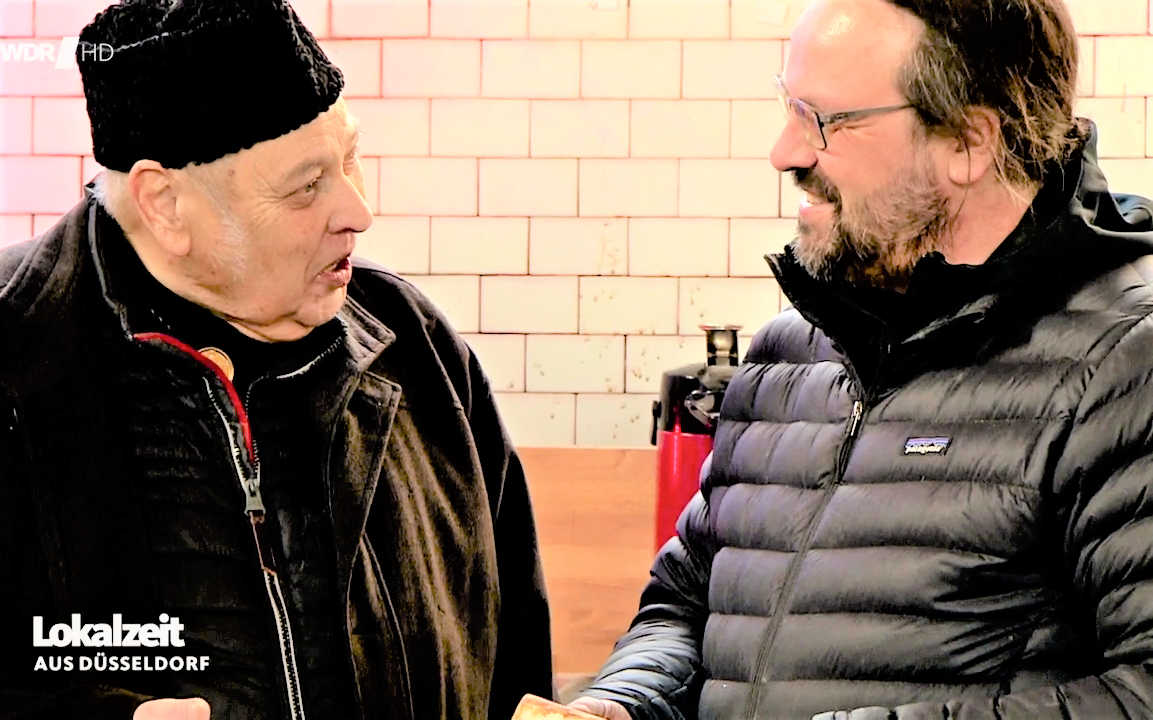
Die beiden „Denkmalverliebten“: Hansgeorg Hauser (links) und Christoph Becker.
So hat sich die Münchener Textilkünstlerin Sonja Weber mit gewebten Bildern einen Namen gemacht. Ihre Exponate werden im Rahmen der von Dr. Ulrike Denter kuratierten Ausstellung „Wasser + Stoff – eine elementare Verbindung“ zu sehen sein. Und zwar im Klärwerk bis zum 31. Oktober und in einer thematisch kompletten Ausstellung im Haus der Seidenkultur vom 10. September bis zum 25. Februar 2024. Mit ihren in Regenbogen-Farben schillernden Jacquardgeweben – in denen flüchtige Bewegungselemente von Wasser und Wolken erschaffen werden – gelingt Sonja Weber ein faszinierender Spagat zwischen den Elementen Wasser und Stoff, die das Thema der Leitausstellung bestimmen.
Ein weiterer Themenschwerpunkt ist im Klärwerk dem Bildhauer, Objekt- und Textilkünstler Georg Ettl gewidmet, der 2014 nach langer Krankheit in Viersen starb. Gezeigt werden seine Kunsteditionen aus Textil und Metall. Im Mittelpunkt stehen zwei großformatige, maschinell gewebte Arbeiten: der Wandteppich „Die Untugenden des Menschen“, der im Jahr 2002 noch zu Lebzeiten Ettls entstand, und der Wandbehang „Krähen und Menschen“ nach einem Entwurf Ettls. Dieser konnte jetzt in Zusammenarbeit mit dem HdS posthum realisiert werden. Die Silhouette der Krähe tauchte zum ersten Mal in 1997 auf, als Ettl mit der Gestaltung des Innenhofes des Kaiser-Wilhelm-Museums in Krefeld beauftragt wurde. Um den Raum zu öffnen, ersetzte der Künstler die Wände des Innenhofs durch einen einfachen, von Krähen überzogenen Zaun.
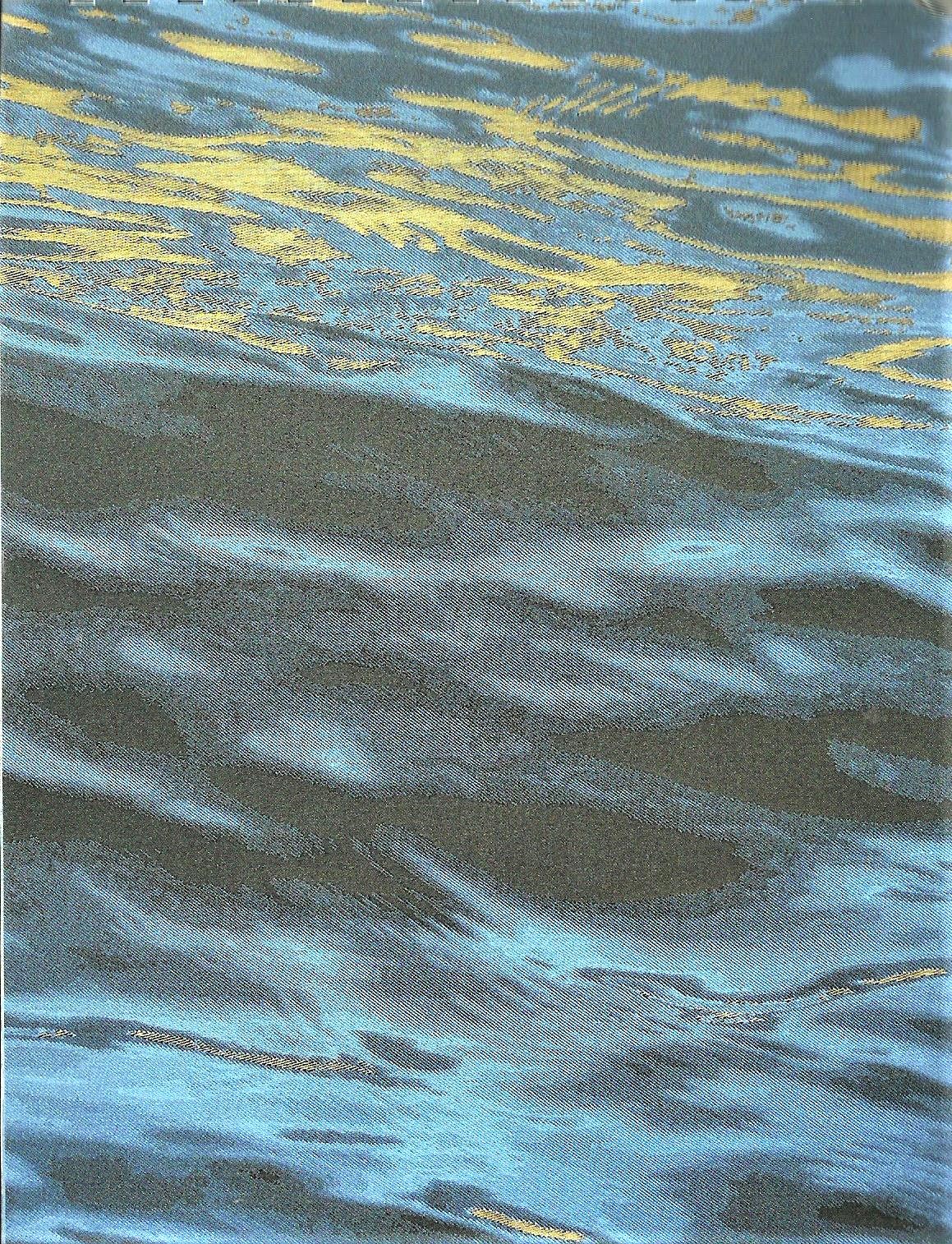
Vor den Werken von Sonja Weber stehend lösen sich die Bilder in eine gewebte Struktur auf, die in den Meereswogen und Wolken auszumachen sind.
Repros (3): HdS
Für die Auftaktveranstaltung der gemeinsamen Jubiläumsaktivitäten vom Klärwerk und HdS konnten die Organisatoren Dr. Walter Hauser, Leiter des LVR-Landesmuseums gewinnen. Ferner den Historiker und Drehbuchautor vieler WDR-Fernsehbeiträge, Helge Drafz. Den musikalischen Part bestreitet der Linner Shanty-Chor. Wer am 1. September um 17 Uhr bei alledem im Jugendstil-Klärwerk mit von der Partie sein möchte, der richte seine Anmeldung bitte per Mail an This email address is being protected from spambots. You need JavaScript enabled to view it.. Eine komplette Übersicht über alle Veranstaltungsaktivitäten gibt es im Internet unter 650.klaerwerk-krefeld.org
650 Jahre Stadt Krefeld: Damit dieses Ereignis wirklich zu einem „persönlichen Schlüsselerlebnis“ wird, bietet das Haus der Seidenkultur (HdS) jetzt zum Auftakt der Festivitäten einen Schlüsselanhänger mit dem Motiv der nostalgischen Skyline-Architektur der Seidenstadt an. Die bekannten Symbole – darunter die Fassaden der Dionysiuskirche, des Kaiser-Wilhelm-Museums und des Rathauses – wurden um die Silhouette des Uerdinger Klärwerks erweitert. „Nicht zuletzt deshalb, weil wir mit dem Klärwerk gemeinsam viele Events zum Stadtjubiläum ausrichten“, wie HdS-Sprecher Dieter Brenner eine „kontrastreiche Festfolge beider Industriedenkmale“ ankündigt.
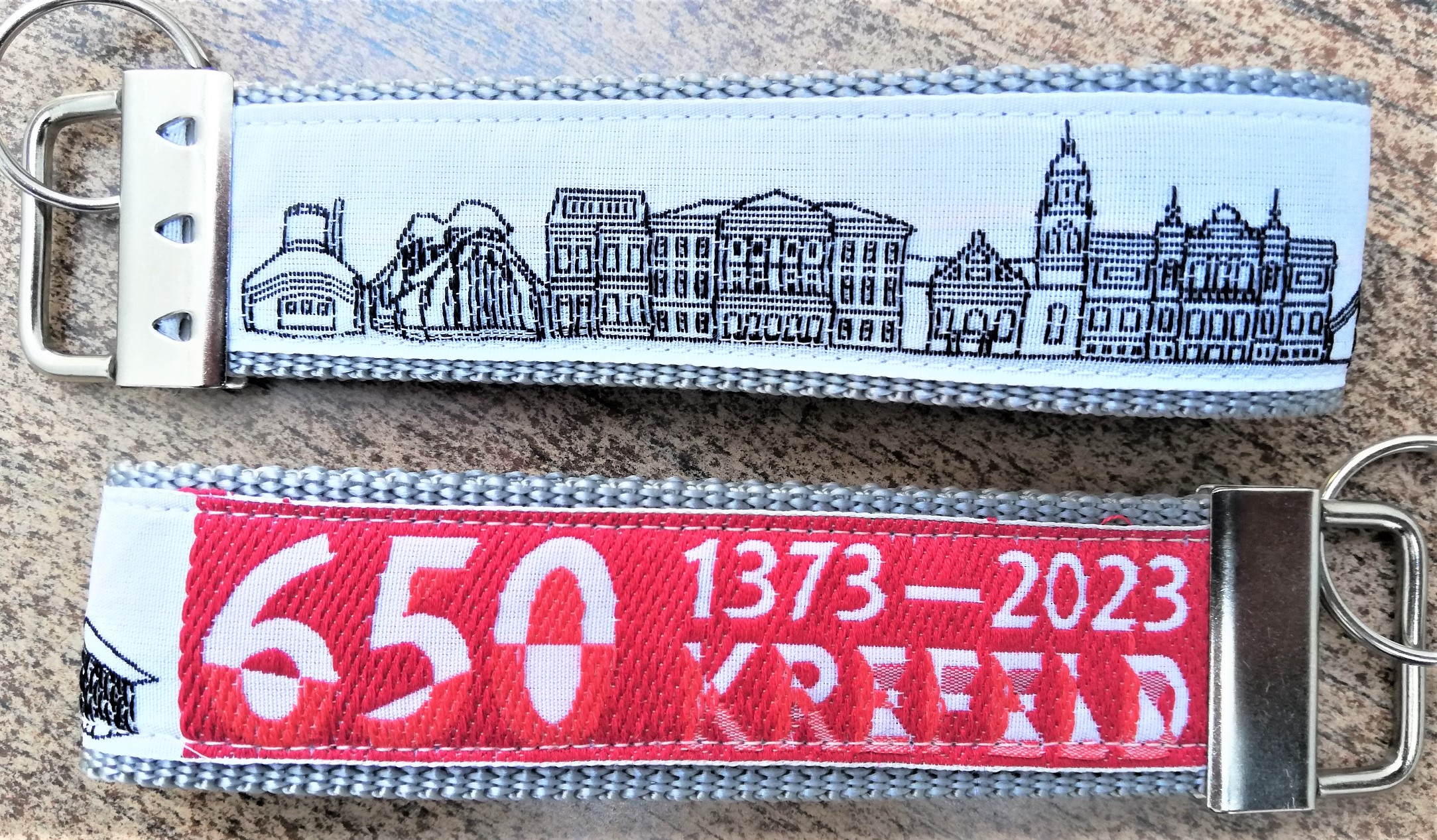
In einer dem Wuppertaler „Kafka-Museum“ angeschlossenen Bandweberei wird der Krefelder Jubiläums-Schlüsselanhänger auf einem Jacquardwebstuhl mit 16 Bändern produziert.
Fotos: HdS
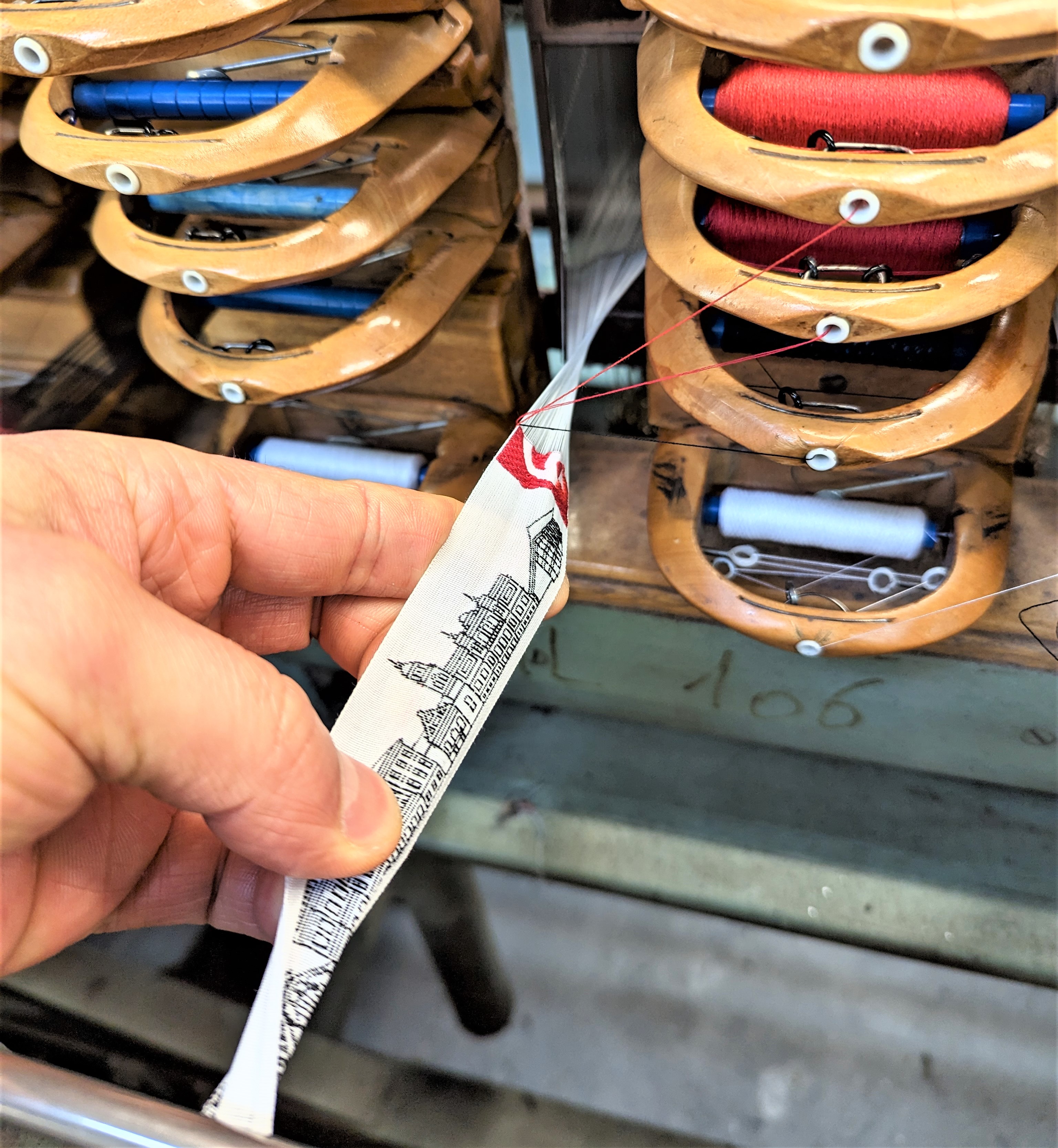
Der Jubiläums-Schlüsselanhänger wurde in enger Kooperation mit dem Krefelder Stadtmarketing entwickelt. Für die technische Umsetzung hat HdS-Projektleiter Jürgen Schmitz das „Kafka-Museum“ in Wuppertal gewinnen können, dem eine Bandweberei angeschlossen ist. So wurde der Schlüsselanhänger stilgerecht auf einem alten Jacquardwebstuhl mit 16 Bändern produziert.
Schmitz: „Beim Gurtband haben wir uns für eine robuste, wetterfeste und extrem strapazierfähige Gurtware aus Polypropylen (PP) entschieden. Sie hat eine hohe Reißfestigkeit, ist hitze- und säurebeständig und waschbar bei 30 ° C. Das aufgenähte Band mit den Symbolen und der farbigen Gestaltung der Jubiläumsfeier ist in der Kette aus Polyester (PES) und im Schuss(-Faden) aus langfaseriger, mercerisierter, ägyptischer Baumwolle gewebt. Auch dieses Material ist waschbar“, verspricht Schmitz einen hohen Tragekomfort.
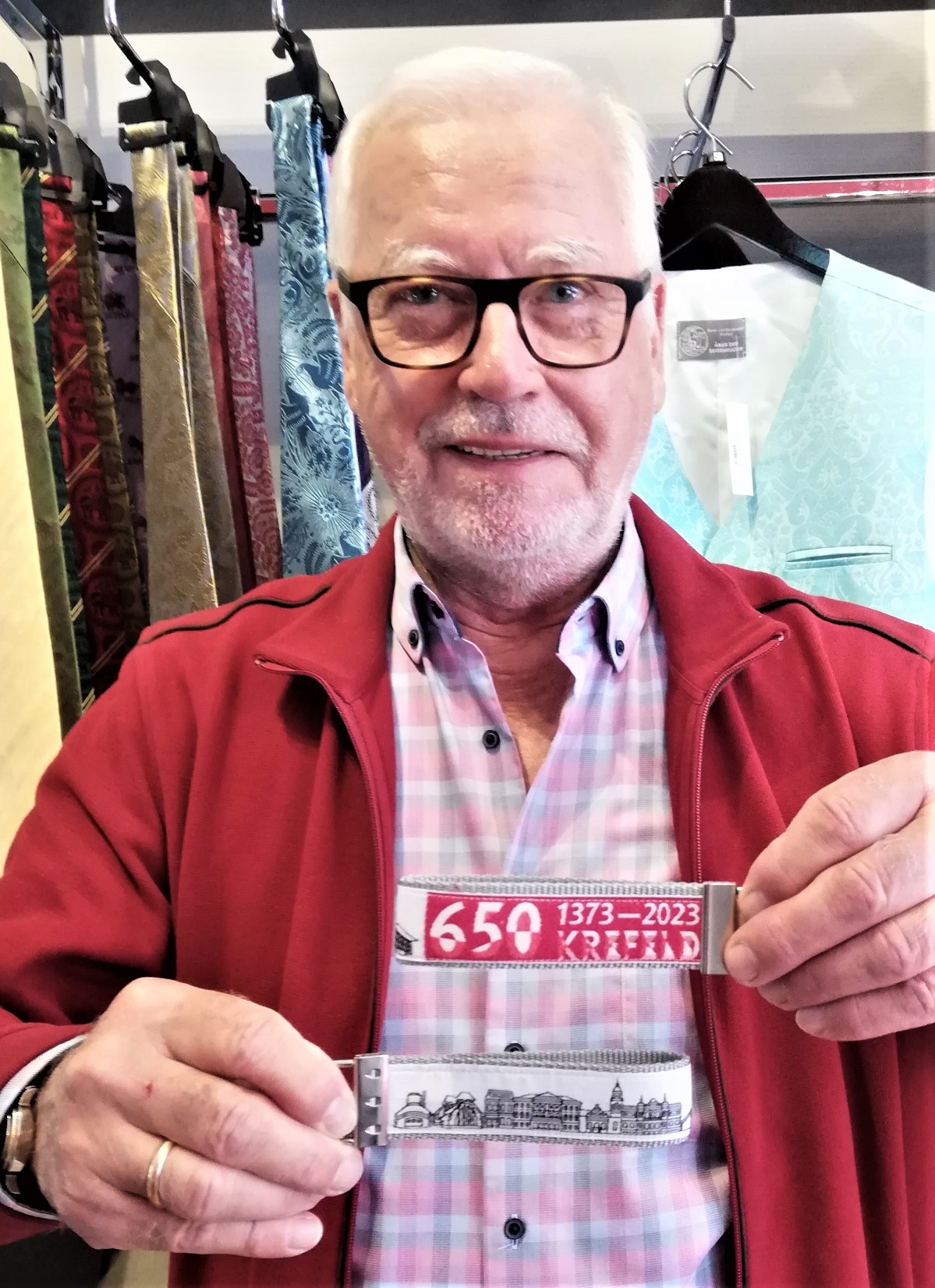
Dipl. Ing. Jürgen Schmitz sorgt als Projektleiter im Haus der Seidenkultur dafür, dass der Krefelder Jubiläums-Schlüsselanhänger sprichwörtlich unter die Leute kommt.
Der Krefeld-Schlüsselanhänger wurde vom HdS in einer Auflage von Eintausend Stück produziert und ist ab Mitte Mai zum Preis von 9.90 Euro an rund 20 Verkaufsstellen in der Stadt erhältlich; darunter in sämtlichen Büchereien, dem Deutschen Textilmuseum und natürlich im Haus der Seidenkultur. Dort kann der Anhänger auch online hier rund um die Uhr geordert werden.
Über den „denkmalverliebten Christoph Becker“ berichtete jetzt das WDR-Fernsehen in der „Lokalzeit“. „Becker hat das Klärwerk mit zwei Freunden gekauft; und immer, wenn Geld da ist wird es saniert“, begann Autor Helge Drafz seine Fernsehreportage. Im Beitrag mit von der Partie unser Hansgeorg Hauser, „der auch schon mal ein Industriedenkmal gerettet und daraus in Privatinitiative ein Museum gemacht hat“, wie Drafz den Zuschauern vor den Bildschirmen die Gemeinsamkeit der beiden Männer erklärte.
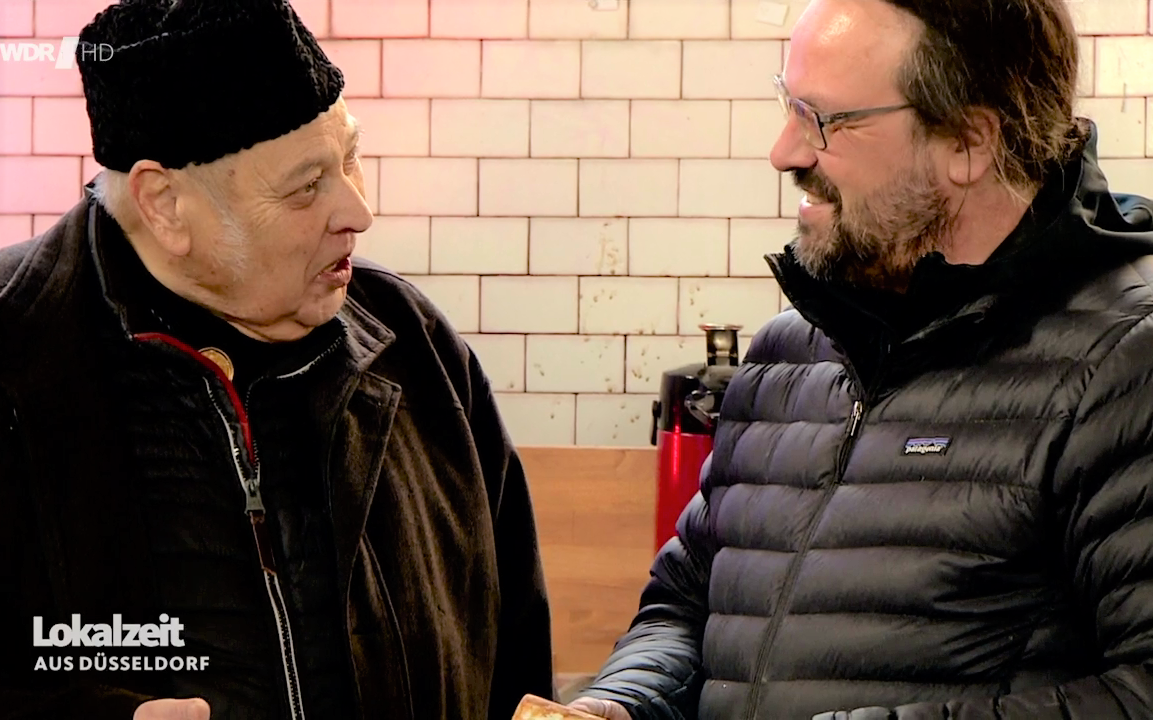
Hauser (links im Bild) zeigte sich dann auch begeistert von den Sanierungsarbeiten seines Kollegen. „Die Krefelder wissen gar nicht wieviel schöne Kleinode sie besitzen“, stellte Hauser mit Blick auf die Industriedenkmäler Klärwerk und Haus der Seidenkultur fest. Beide Einrichtungen planen gemeinsame Aktivitäten zum anstehenden Stadtjubiläum. „Daher müssen sie jetzt im Klärwerk Gas geben, damit im Spätsommer alles fertig ist“, kommentierte Drafz die Reportage über die aktuellen Baufortschritte.
Becker selbst war live im Düsseldorfer Lokalzeit-Studio, wo er nach Ausstrahlung des Filmbeitrags von Moderatorin Laura Rohrbeck interviewt wurde. Insgesamt fast zehn Minuten widmete das WDR-Fernsehen dem Beitrag aus Krefeld, „wo das Klärwerk einst als Symbol für eine moderne Stadt galt“, wie Helge Drafz abschließend feststellte. In unserer eigenen Mediathek haben wir die Sendung bei YouTube für euch eingestellt.
Handwerkskammer honored hand weaver for his life's workrong>
"I was allowed to turn my hobby into a profession," says hand weaver Günter Oehms, who - as museum director Hansgeorg Hauser put it - "is one of the "figureheads of the House of Silk Culture (HdS)". Now the 87-year-old has been awarded the diamond for his life's work Master's certificate from the Chamber of Crafts "for 60 years of active, successful professional life as a master of the weaving trade, which has become rare". The presentation of the rare document took place with Dr. Axel Fuhrmann, the general manager of the Düsseldorf Chamber, visited the former Hubert Gotzes parament weaving mill at Luisenstraße 15 in Krefeld.
"Günter Oehms is a textile specialist who is second to none," said Fuhrmann in his laudatory speech. And: "He is a technical expert on everything to do with the mechanical engineering of the handloom of European standing." Against this background, our Günter was able to significantly increase the level of awareness of our museum far beyond the borders of the velvet and silk city," Hauser took up the words of the previous speaker.
Günter Oehms – born on May 22, 1935 in Trier – as the eldest of three children, began an apprenticeship as a businessman in Manderscheid (Eifel) in 1949, which he passed with flying colors three years later.
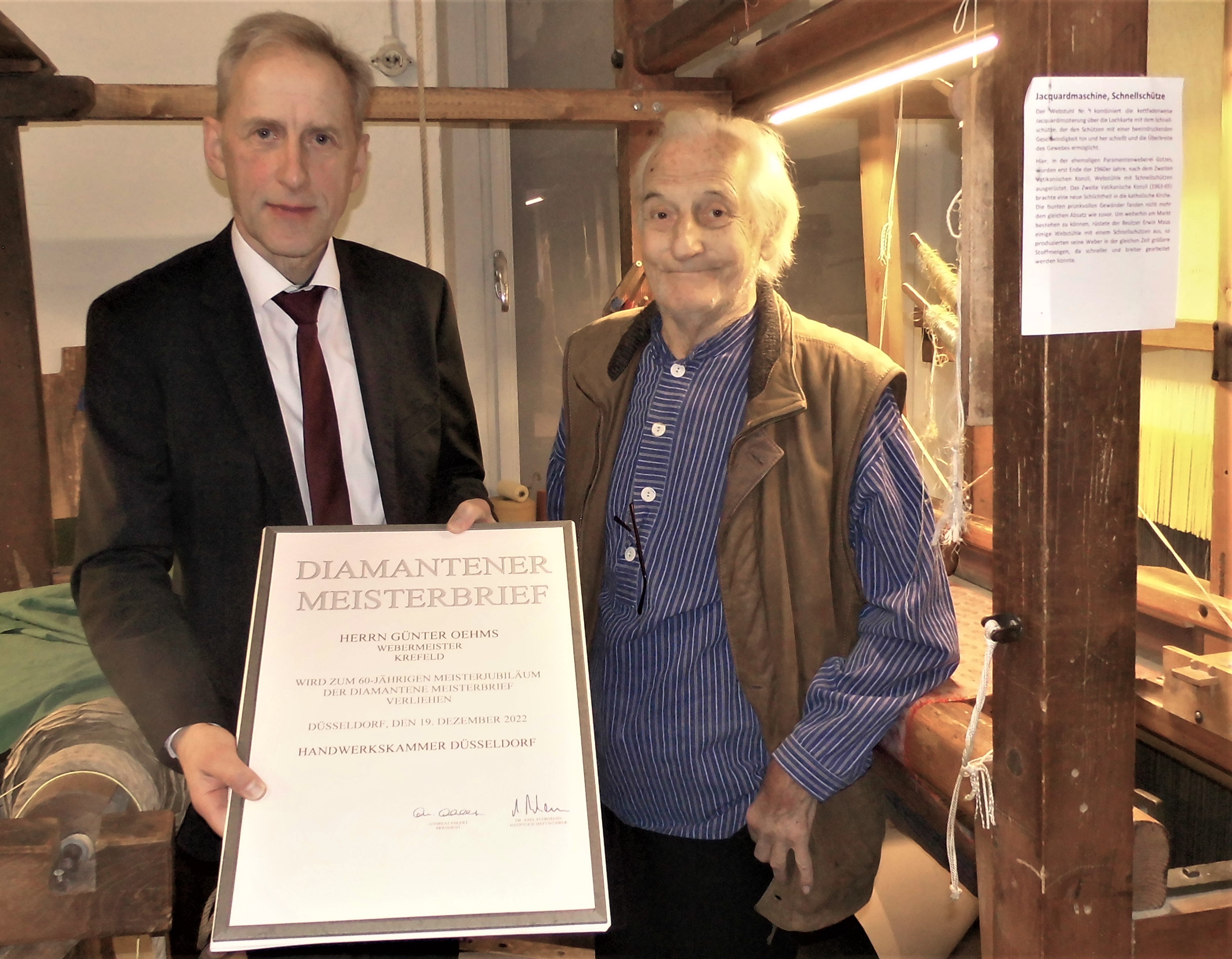
Oehms: "The office chair wasn't for me!"
But young Oehms soon realized that he didn't want to grow old on an office chair. Rather, he was fascinated by the craft and especially the guild of weavers. Even as a child he had come into contact with a loom on a nearby farm. In 1953 he then put his dream job into practice and began an apprenticeship as a hand weaver at Arras Castle in Alf on the Moselle.
With his journeyman’s certificate in hand, he came to the velvet and silk city in 1956, where he found a job as a young journeyman in the tie and hand weaving workshop “Sugora”.
With talent and diligence, he was already working his way up the company to become a master craftsman, even before he was officially awarded this title in 1962. He had previously attended the master school in Krefeld and passed the master craftsman's examination at the Düsseldorf Chamber of Crafts.
Other stations in his professional career included the companies "Kleinod" and "Meister-Krawatten", where he worked as a cutter and team leader.
As a master craftsman, he was also in great demand at the Werkkunstschule in Krefeld, where he taught parallel to his professional activity as a lecturer in hand weaving from 1965 to 1971.
"I then retired in 1994," says Günter Oehms, explaining that he too was not spared from the slump in the textile industry. But the loom - one of them was and still is at home - was to continue to be a significant part of his life in the future.
Dipl. text engineer Walter Tillmann, whom Oehms met at the 100th anniversary of the Girmes in the Oedter Albert Mooren Halle, was not entirely innocent in this development. The motto after a first meeting was published quite quickly: "We absolutely have to do something together!"
This intention resulted in the founding of the small textile museum “Die Scheune” in Hinsbeck in 1983. There he finally came into (first) contact with members of the Krefeld "House of Silk Culture", where Günter Oehms has been letting the old Jacquard looms "clatter" again since the turn of the millennium.
Oh yes: In between there was also a little time for (purely) private things: Günter Oehms married Susanne Leßmann in 1960; this marriage produced three children. The family showed great understanding that the head of the family was always “married” to the loom.
Looking at the eventful (professional) life of the awardee, Dr. Fuhrmann summarized at the impressive ceremony: "Krefeld and the entire trade on the Lower Rhine and beyond owe a lot to Günter Oehms and his work!"
Biography of a man who doesn't want to "brag".
In many places, the hand weaver's advice and action was and is very much in demand. Only reluctantly - because he "doesn't want to brag" (show off) - Günter Oehms lists some stations of his voluntary work here and names institutions and places where he staged the old weaving trade.
- Wegberg Flax Museum in Beeck
- Weberhaus St. Hubert (here he set up looms)
- Museum Horst (NL)
- Hansenhof local history museum in Velden (NL)
- Schlesierhaus Heisterbacher Rott in Bad Godesberg
- Flax market in Krefeld-Linn
- Heimendahl estate in Kempen (including participation in the "Day of the Court")
- Himmerrod Monastery (participation in the "Klostermarkt", one of the oldest craft markets in the Eifel)
- Home club Viersen
- Manderscheid fair
- Alexius Hospital Neuss (where he led a therapy group for almost 1 year).
- Participation in various village festivals in the Eifel, such as the Obergöttlinger 1,200 year celebration or the festival in Pantenburg.
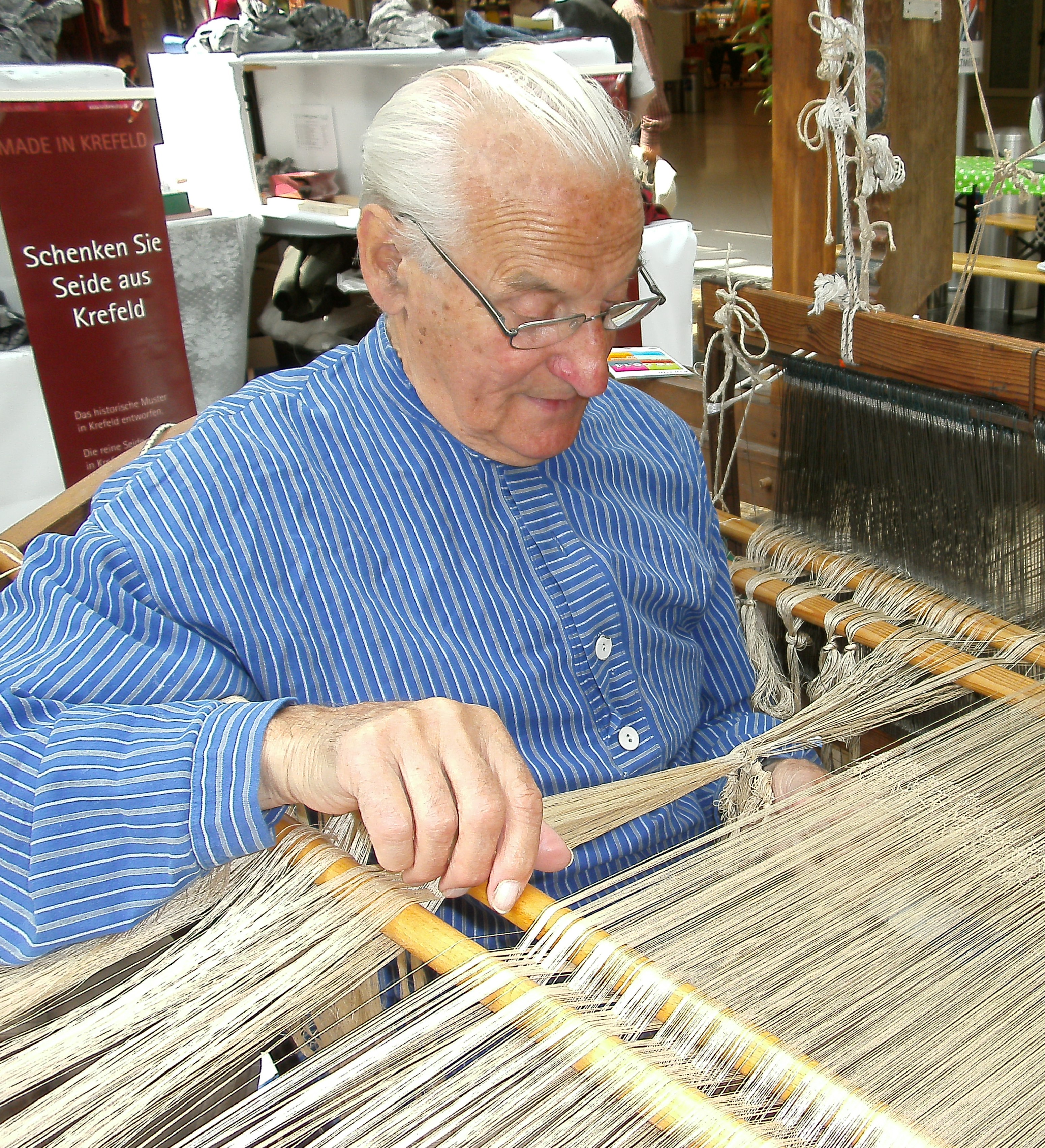
The Bauhaus student, textile designer, graphic designer, artist and university teacher Prof. Annette Pöllmann died on October 16 at the age of 96 . This sad news reached the public these days from our House of Silk Culture (HdS), where the Bauhaus icon enriched the museum's advisory board with her diverse artistic skills.
For many, Annette Pöllmann was the Bauhaus student who had studied with Georg Muche and Elisabeth Kadow and was a professor at the Krefeld Textile Engineering school (later Niederrhein University of Applied Sciences) demanded the highest quality from its classes. For others, she was the pioneer of silk painting, the tirelessly creative person who, when invited, asked her guests to draw the radishes at the buffet before they were eaten because they glowed so appetizingly red.
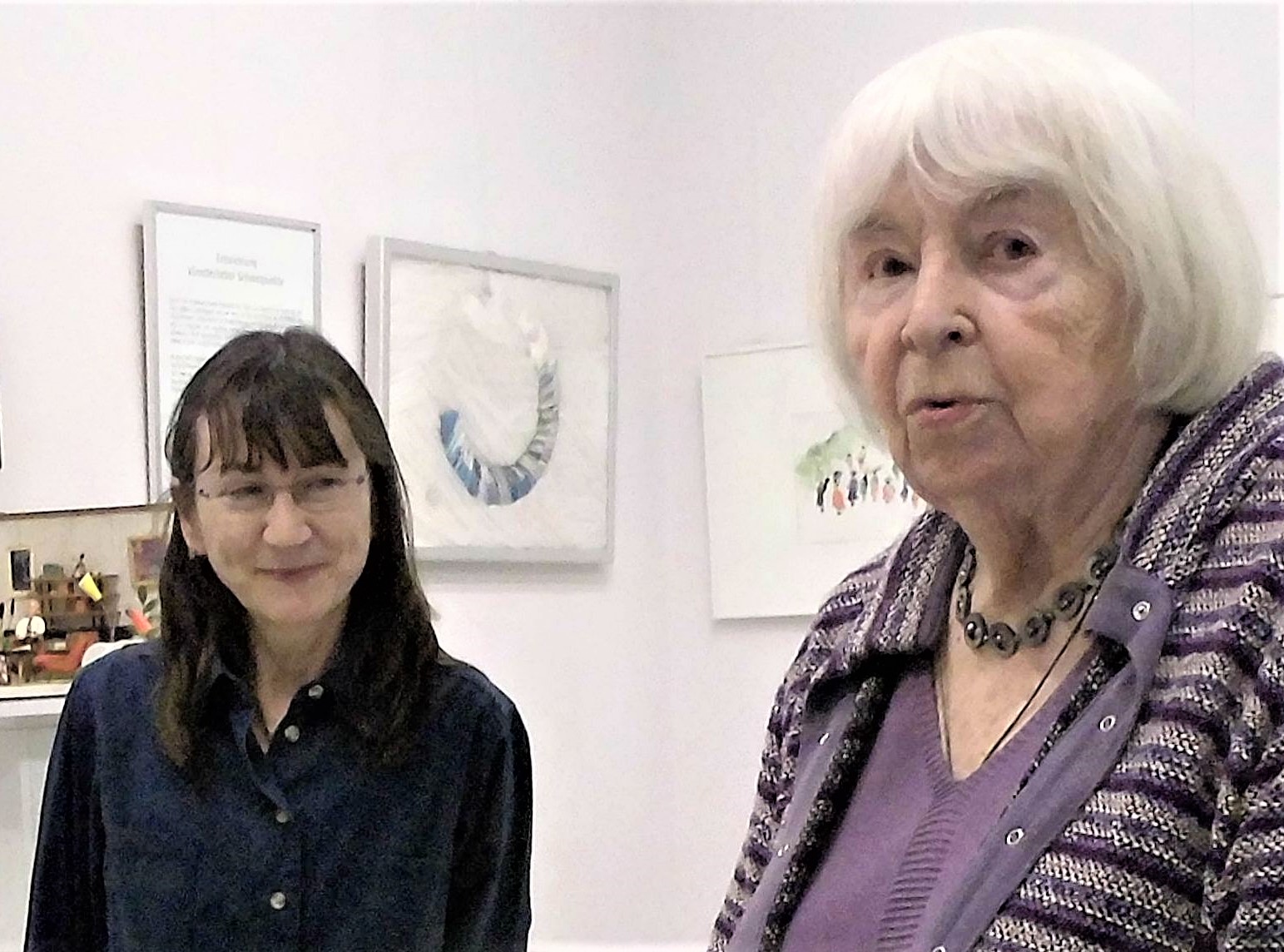
Annette Pöllmann (right) opened in 2017 together with curator Ulrike Denter the exhibition "When the patterns learned to walk".
"Everyone will remember her warmth of heart, her incorruptible judgment and her fine sense of humour," writes Petra Diederichs in an obituary in the Rheinische Post. And: "Annette Pöllmann, who has made a name for herself beyond the borders of Europe, was always creative - almost until her last days." She was constantly looking ahead and looking for something new.
The advice she gave, especially to young people: "People, never give up, even if you have to face defeats !“ And she knew what she was talking about: as a university graduate she had to deal with 113 rejection letters when she was looking for a job because, as a “wild Picasso”, she was once again a step ahead of her contemporaries with her ideas.
Since her retirement, she has increasingly used the Haus der Seidenkultur as a platform for her textile art over the past decade. "When the patterns learned to walk" was one of her last major exhibitions in 2017, which she organized together with Dr. Ulrike Denter curated. This collaboration grew into a great friendship between the two textile workers.
"With Annette Pöllmann, a large chapter of Krefeld's textile culture is being buried," says our museum director Hansgeorg Hauser, who in May of this year together with Pöllmann opened the current exhibition "Iridescent pearls hanging by a thread". The exhibits came from her sister Margarete Schumacher.
The "Queen-Mum" of silk culture, as Pöllmann was dignified in our museum circles, spent the last few weeks at the "Bonhoeffer -A house". The funeral will take place in the middle of next week with your family in your birthplace in Iserlohn.
"But her path in life led Pöllmann to Krefeld early on," says Christian Oscar Gazsi Laki, Head of Culture at WZ, leafing through the artist's biography Among other things, she studied free graphics at the Düsseldorf Academy, until she became a professor at the Niederrhein University of Applied Sciences in Mönchengladbach in 1972, where she taught textile and clothing technology with a focus on textile design.
"The life's work of the multi-talented artist will always live on in the House of Silk Culture," says the obituary of the museum's mourners.< /span>
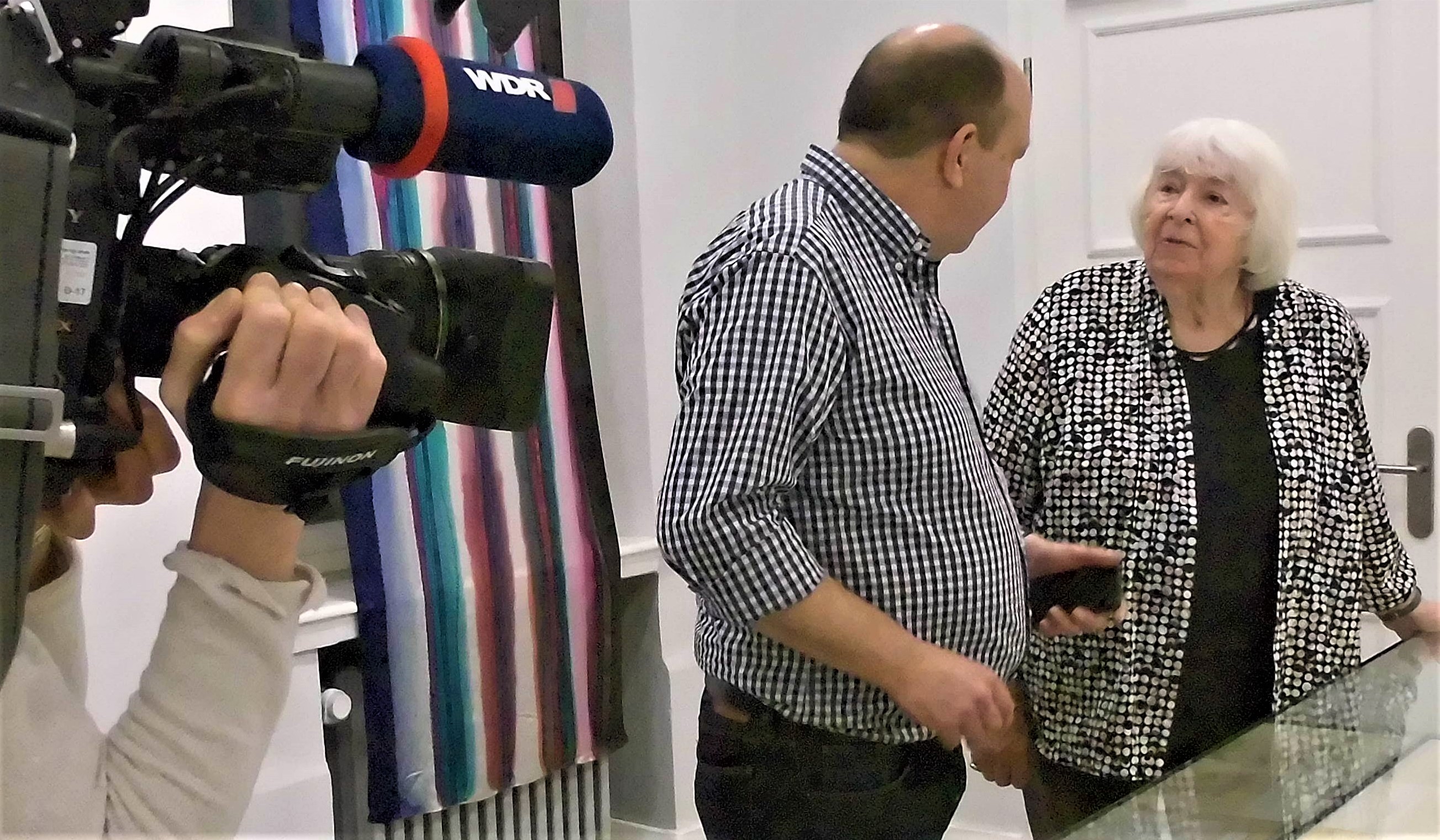
Annette Pöllmann stood in front of the television camera several times in the House of Silk Culture . Here in conversation with WDR author Helge Drafz.
HdS photos: Brenner
Haus der Seidenkultur is right up to the minute when it comes to things digital. Virtual museum guides, treasure hunts and the nine-Euro public transport ticket attract more and more visitors.
VON PETRA DIEDERICHS
Wolsig 52 had never been to the centre of Krefeld before. “During our walk we discovered that there are also quite interesting spots here” according to the post which arrived at Haus der Seidenkultur (HdS). Just one of numerous feedbacks which the team at “the oldest weaving workshop for ecclesiastical textiles in Europe” as the HdS spokesperson Dieter Brenner likes to emphasize, received. For the past two years the Silk Museum has also been offering its town tour “Walk along silk routes” as a geocaching option. This digital tour of discovery has made such an impact that the two sections will be supplemented with a third section in the autumn. Together with curator Ulrike Denter, Volker Vander, himself a passionate geocacher, is currently developing this third tour which will lead around the Hüls district.
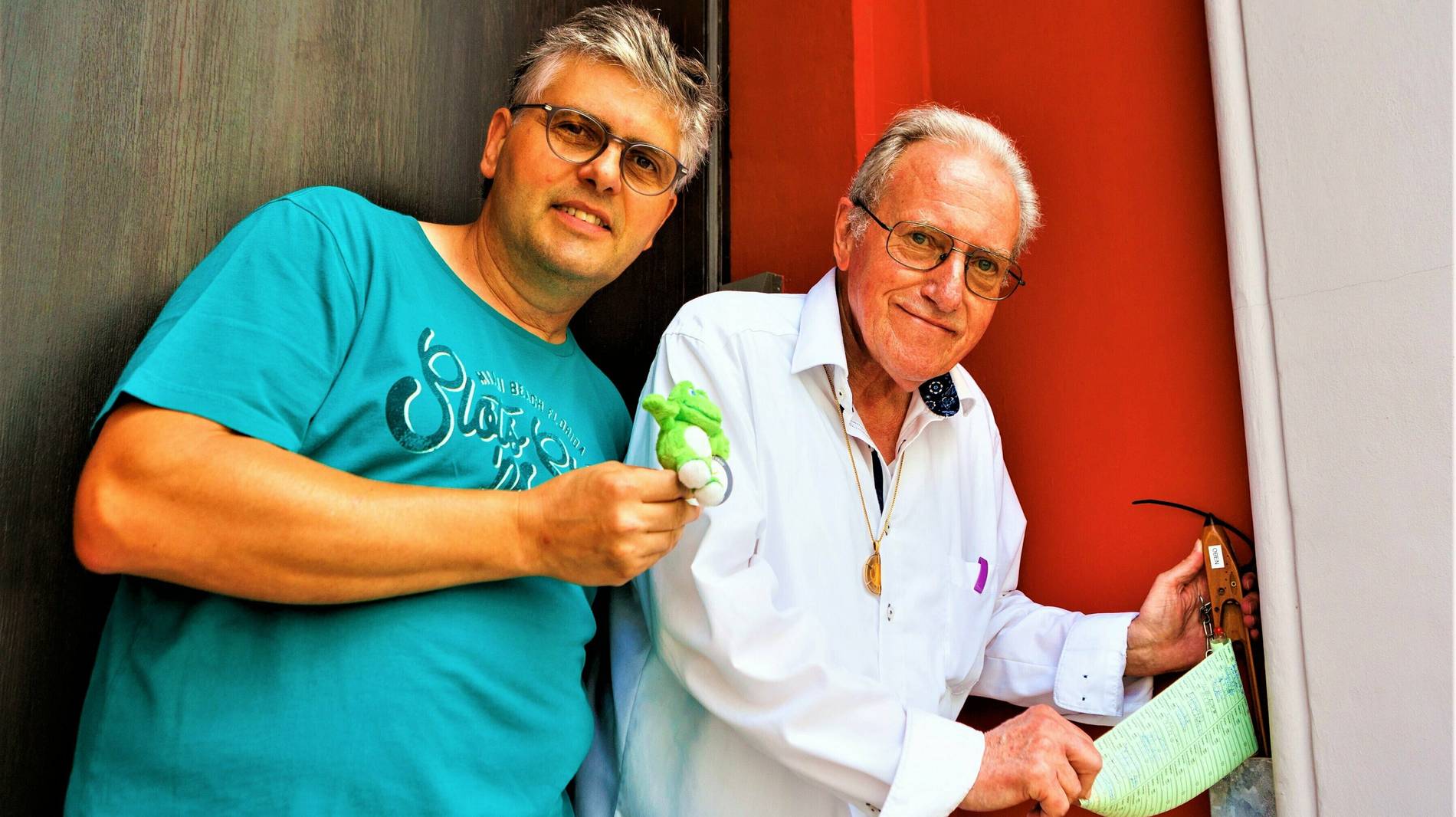
Over the past two years 365 starters have undertaken the Krefeld geocache-tour, 350 of them have followed both routes right to the end. “As most people pursue geocaching in groups, one could say that more than 1000 persons have walked in Krefeld”, says Vander who runs a market garden professionally.
Actually the idea was a make-shift solution brought about by Corona. “At the time we said, if the people are not able to come to us then we must reach them in another way”, says Brenner. And therefore the popular walking tour about the textile history of the town was converted to a digital paper-chase and was exceptionally well received. The nine-Euro public transport ticket has led to another boom. “We reach people in completely different places who have never been to Krefeld”, says Brenner. “And some then also go shopping here”.
Geocaching was introduced into the internet from the USA on May 30th 2000. “Worldwide seven million people take part in the game“, says Vander. The idea is much older: “In the 18th century there were already small boxes at summit crosses where people could leave their name to prove that they had been there,” relates Vander. Geocaching functions basically in the same way but it involves tasks and rewards. Along a secret route, the course of which one has to work out by solving riddles, one arrives at a treasure in a cache. It is hidden in a box together with the so-called logbook in which the successful geocachers sign their name. “As a bonus there is a cocoon at Haus der Seidenkultur from which one can reel silk“, says Brenner.
At each location of the silk rally the cacher finds a video. “I was very lucky to be able to use films from Haus der Seidenkultur for this“, says Vander. Naturally he doesn’t want give away what the questions cover nor which path has to be taken. Strict geocacher law. A little hint: A sentence written in red is involved.
Those who visit Haus der Seidenkultur personally in future can hope for a digital escort – an avatar explains the history and the craft and everything concerning silk from the silkworm to fine fabric. Ten tablets are now available for individual visitors who do not have the opportunity to experience a guided tour. Now they can just click on all the information in pictures, sound and text depending where their interest lies. “The tablets are also suitable for the hearing impaired”, says Brenner.
The information programme lasts for two hours and visitors can choose which information they would like. The digital upgrading at Haus der Seidenkultur was possible thanks to EU-sponsorship relating to digitalisation of former crafts.
Important visitor at Haus der Seidenkultur: the president of the Landschaftsverband Rheinland (LVR), Ulrike Lubek, paid a visit to HdS accompanied by her Personal Assistant, Carmen Heyner. Actually just a short visit was planned but the LVR director was very impressed by our museum. In particular the nostalgic weaving hall where master weaver Manfred Weisters enticed a skilful “click-clack” from the old looms awakened her interest.
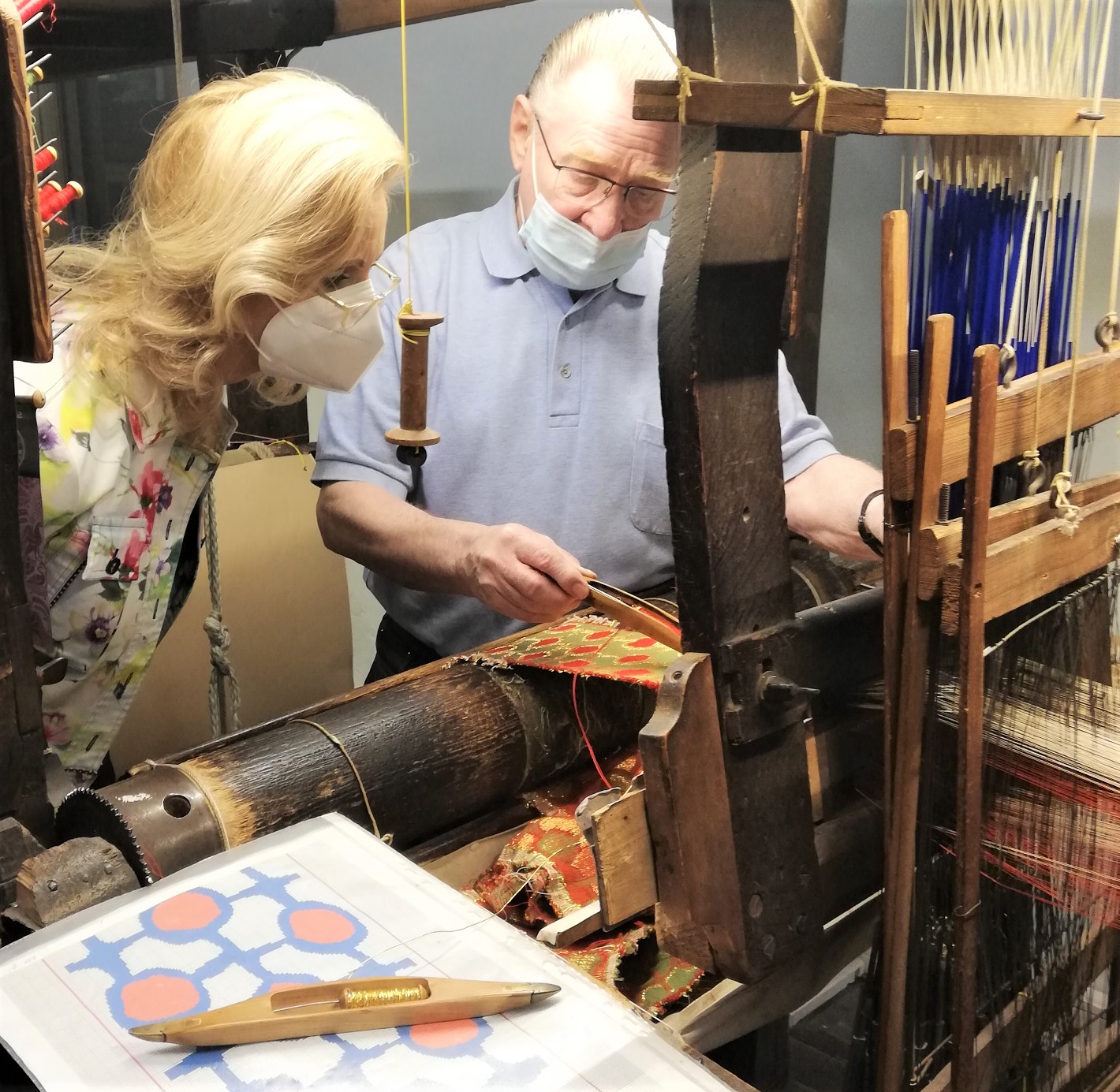
Lubek also described our establishment as a “gem in Krefeld“, when signing the visitors’ book expressing her “sincere appreciation” for the exclusive guided tour. The head of the museum Hansgeorg Hauser, who was awarded the much treasured “Rheinlandtaler” by the LVR a few weeks previously, was naturally very pleased about that.
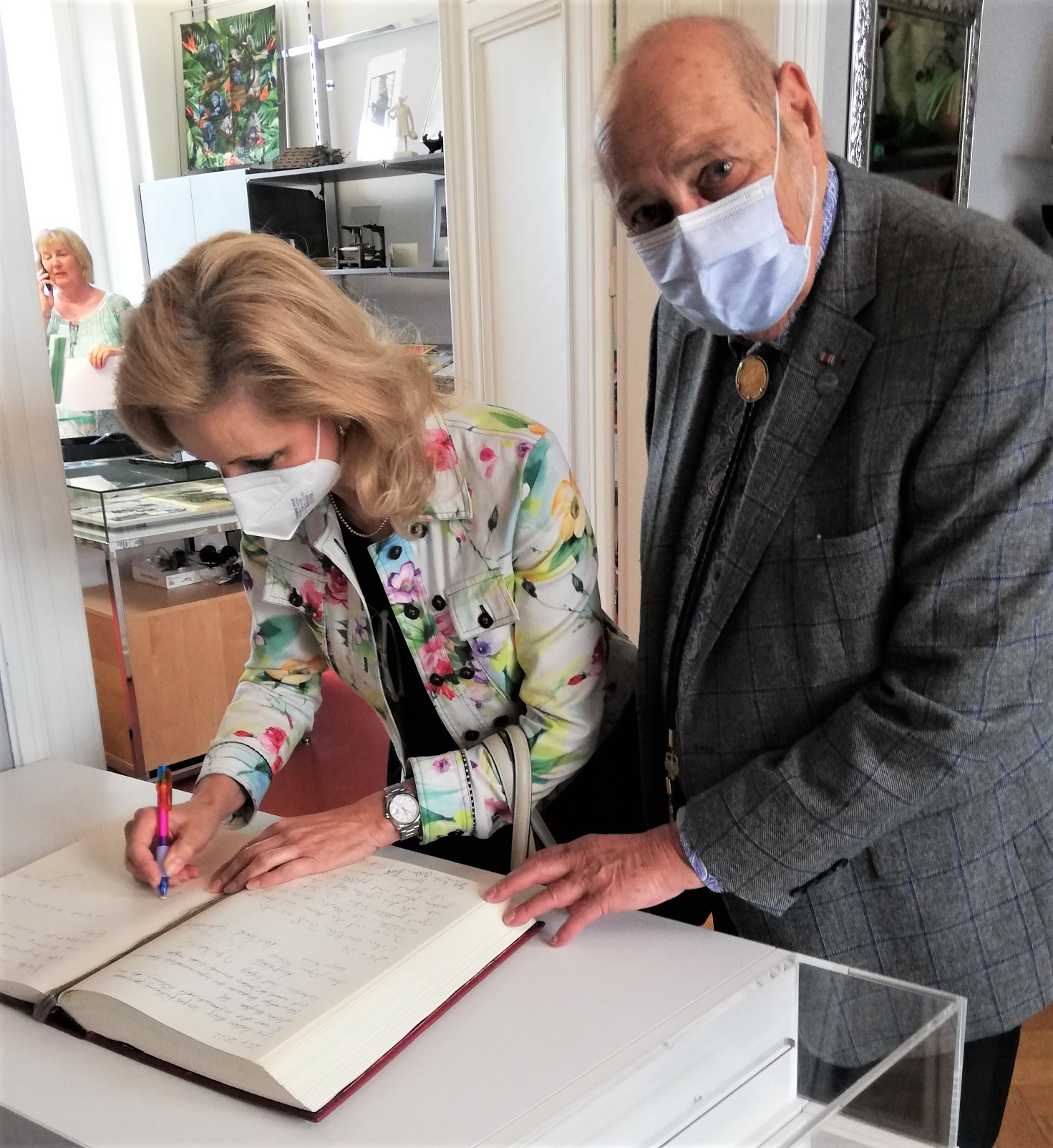
As a communal organisation, the LVR performs services in connection with youth welfare, support for the handicapped, in the field of psychiatry and in the field of culture throughout the Rhineland. It is the largest key player for persons with a handicap in Germany and it runs 41 schools, ten clinics, 20 museums and cultural establishments, four youth welfare facilities, the state youth welfare service and the remedial support network. More information about the LVR can be found here: https://www.lvr.de
